Almost a third of Montana is state and federal land with some areas designated specifically as “Waterfowl Production Areas (WPA)”. So you know there is going to be ample opportunities for duck hunting from season opener on to the end of January. Greenheads, pintails, gadwalls and goldeneyes all flock to the open waters in Montana. With the Missouri River, Flathead River and numerous small lakes and ponds scattered throughout the state you’re going to want to get out there this season. Here is everything you need to know about duck hunting season in Montana including season dates, bag limits and more!
What Kinds of Ducks are in Montana?
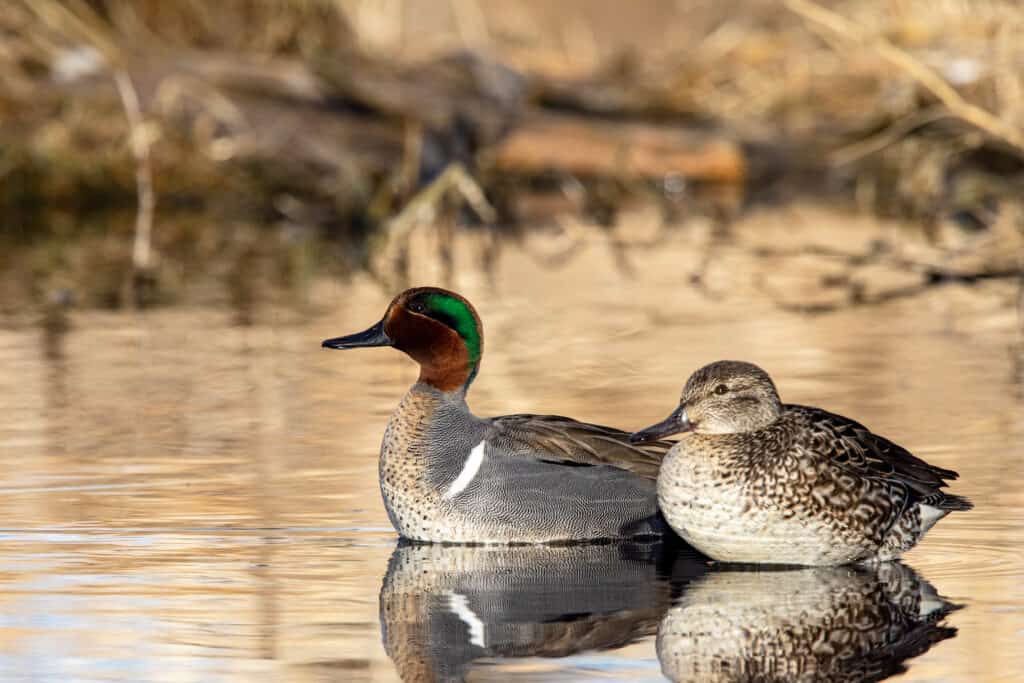
The most striking feature of the green-winged teal is the matching green crescent on their heads and green patch on their wings.
©J Edwards Photography/Shutterstock.com
The three most common ducks harvested in Montana are mallards, wigeon and green-winged teal. You will find mallards and goldeneyes all the way into January but other species migrate through on their way south for the winter. There are blue-winged teal and green-winged teal, pintails, gadwalls and shovelers. Less commonly seen are wood duck, lesser scaup and redheads.
Where can you Duck Hunt in Montana?

There are multiple points along the Flathead River have duck and geese in the Flathead WPA.
©iStock.com/highmountainphotography
In Montana you can hunt at National Wildlife Reserves (NWR), Wildlife Management Areas (WMA) and Bureau of Land Management (BLM) land. There are multiple duck hunting areas along the Missouri River including the Charles M. Russell NWR. Also multiple points along the Flathead River have duck and geese in the Flathead WPA. You can hunt at some of the State Parks as well as on private land with permission from the owner.
What are the Hunting Zones in Montana?
Montana is split down the middle between the Pacific Flyway and the Central Flyway. Different regulations and season dates apply to each Flyway. In addition, the counties in the Central Flyway, in the eastern half of the state, are divided into two zones, Zone 1 to the north and Zone 2 to the south (with the exception of Powder River, Carter and Fallon which are in Zone 1).
Duck Hunting Season Dates in Montana
Pacific Flyway
| SpeciesPacific FlywayDuck and Mergansers | Oct 1 – Dec 25 and Dec 26 – Jan 13 |
| American Coot | Oct 1 – Jan 13 |
Central Flyway
| Species | Zone 1 | Zone 2 |
| Duck and Mergansers | Oct 1 – Jan 5 | Oct 1 – Oct 9 and Oct 22 – Jan 17 |
| American Coot | Oct 1 – Jan 5 | Oct 1 – Oct 9 and Oct 22 – Jan 17 |
Other Season Dates
| Statewide | |
| Youth Waterfowl Days | Sept. 24–25 |
Bag Limits and Possession Limits for Duck Hunting in Montana
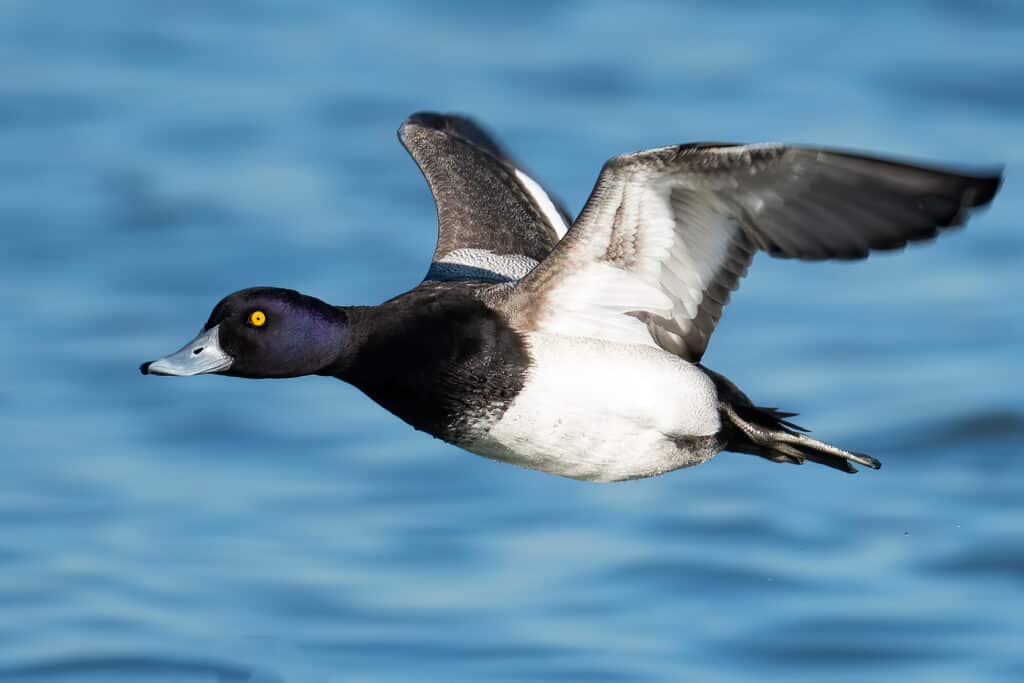
The bag limit for ducks in Montana depending on the zone you are in.
©Brian E. Kushner/Shutterstock.com
Pacific Flyway
The daily bag limit in the Pacific Flyway is 7 ducks or mergansers. Daily bag limit shall not include more than 2 hen mallards, 1 pintail, 2 redheads, 2 canvasbacks and 2 scaup.
| Species | Bag Limits | Possession Limits |
| Ducks | 7 | 21 |
| Mallards (limit of 2 female) | 7 | 21 |
| Pintail | 1 | 3 |
| Redhead | 2 | 6 |
| Canvasback | 2 | 6 |
| Scaup | 2 | 6 |
| Coot | 25 | 25 |
Central Flyway
The daily bag limit in the Central Flyway is 6 ducks or mergansers. The daily bag limit shall not include more than 5 mallards of which no more than 2 may be hens, 3 wood ducks, 2 redheads, 2 hooded mergansers, 1 pintail, 2 canvasbacks and 1 scaup. During the first 9 days of the regular duck season in both Zones (Oct 1 – Oct 9), the daily bag may include 2 additional blue-winged teal.
| Species | Bag Limits | Possession Limits |
| Ducks | 6 | 18 |
| Mallards (limit of 2 female) | 5 | 15 |
| Wood Duck | 3 | 9 |
| Redhead | 2 | 6 |
| Hooded Mergansers | 2 | 6 |
| Pintail | 1 | 3 |
| Canvasback | 2 | 6 |
| Scaup | 1 | 3 |
| Blue-winged teal (first 9 days) | 2 | 6 |
| Coot | 15 | 45 |
What are the Shooting Hours?
The shooting hours in Montana are ½ hour before sunrise to sunset.
Gear up! What is the Best Gear for Duck Hunting?
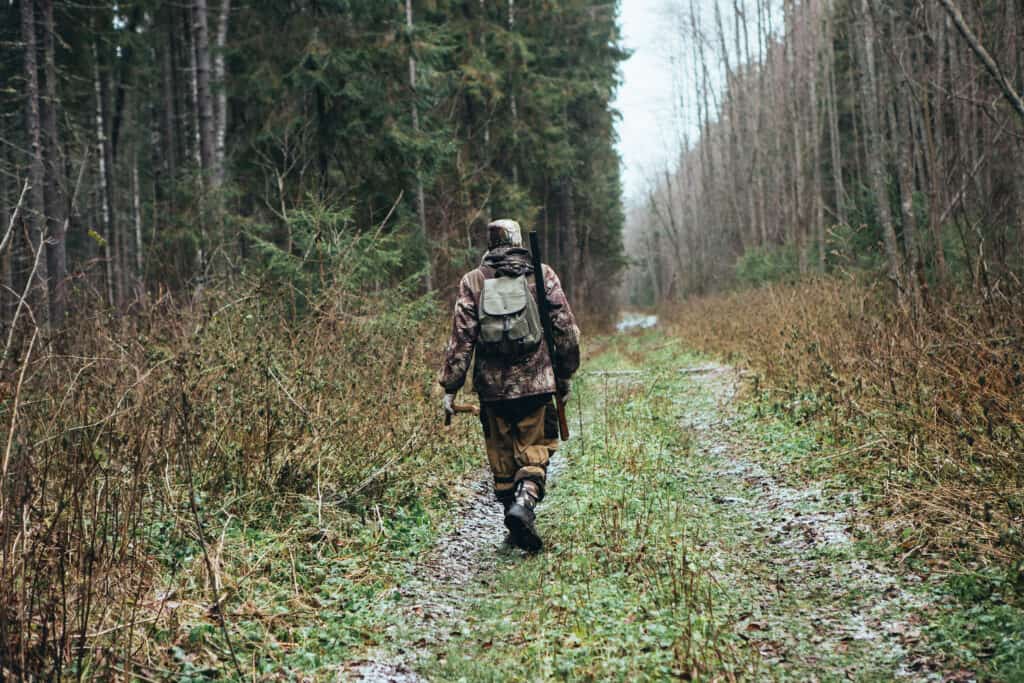
Duck hunting has a reputation for being gear heavy, but it doesn’t have to be.
©Scharfsin/Shutterstock.com
If you’ve been invited to tag along on your first duck hunt or you want to give it a shot (literally) here is a starter list of gear you will need for duck hunting season in Montana:
- Shotgun: a 12 gauge or 20 gauge, can only hold three shells
- Gun case/bag/sleeve: waterproof is a must
- Shells: 3” shells are common, shot must be nontoxic
- Decoys: Not only do you want to pick out the most realistic looking decoys but you want to study different patterns to set up your spread. Some popular duck spread patterns include the fishhook (or J-hook), horseshoe (or U-hook), L-spread and the X with the blind in the middle.
- Duck callers: A leather lanyard full of duck callers isn’t necessary, but having a good caller (or two) that you know how to use really well is. Practice, then practice some more, to imitate the species of your choice as close as possible. Especially if this is your first time out since last year.
- Cooler: If you haven’t met your bag limit you know you’re going to want to stay out for “just one more hour”, so be prepared for a day in the blind with a cooler full of water, snacks, a couple of sandwiches and a “healthy” supply of beef jerky!
What is the Best Kind of Blind?
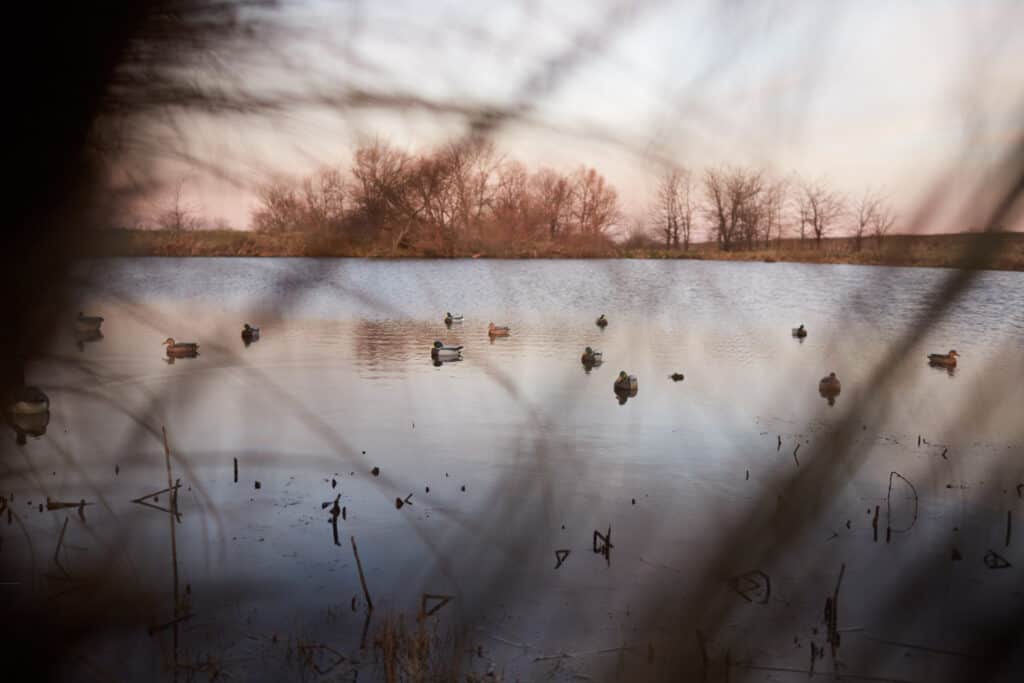
If you are planning a more extensive hunt or are hunting with a larger party you really do want to have a quality blind.
©CLP Media/Shutterstock.com
The best blind depends on the kind of hunting you are doing. Will you be hunting at a park with ample parking, a boat ramp and blind system or are you planning on wading in with just your dog? For a boat blind you can take out a duck boat with a built in blind or you can boat to an area and set up your blind. Portable A-frames work well in this situation. If you decide to hike in/wade in and you are in low lying reeds and brush you might want to set up a layout blind. For hunting on your own private land you can have a pit blind installed for the ultimate in comfort, warmth and space. These can accommodate several hunters and their dogs with the ability to stand up while they wait. With so many options experiment with what works for your hunting style.
What Should you Wear Duck Hunting?
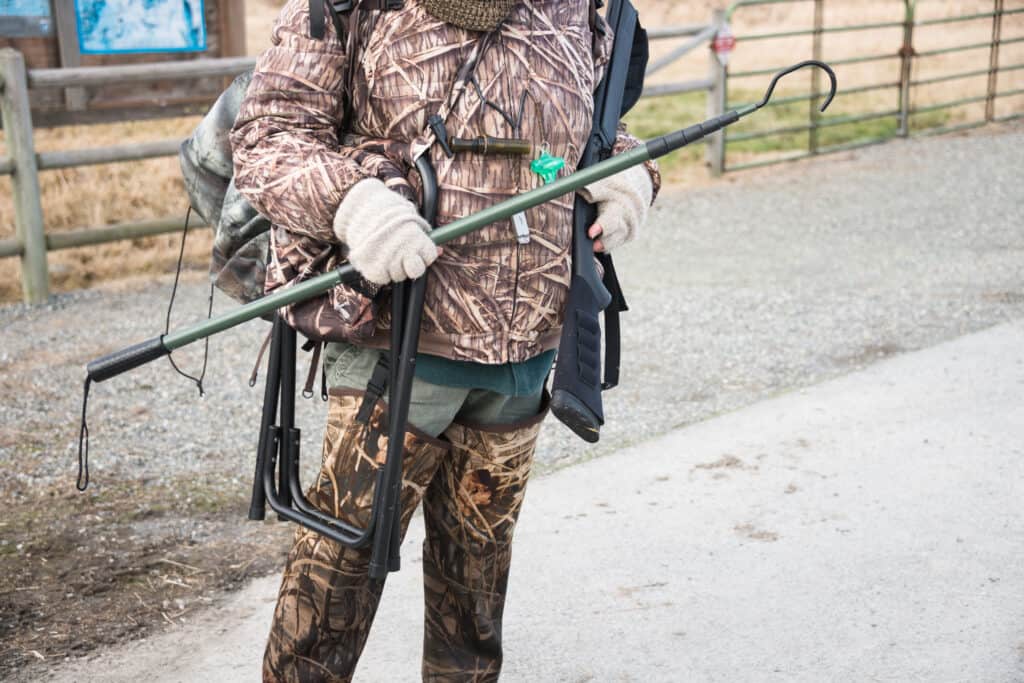
The right gear can make a big difference between a miserable cold, wet, duckless day and a well prepared exciting day of meeting your bag limit.
©Denise Lett/Shutterstock.com
Duck hunting is known to be cold, wet and muddy so dressing for the elements is very important. Here is what you should wear for duck hunting:
- Boots: Your boots are one of your most essential items you need to have. They need to be waterproof, lined and comfortable. You will run into all kind of debris, downed trees and muddy rocks while you are wading through duck country. Sturdy boots are a must.
- Waders: If head out to retrieve a freshly shot greenhead you could end up in knee deep mud…or worse. You are going to want to have a good pair of waders. They are going to keep you warm and dry so you can stay out until your bag limits are met.
- Camo: All of your outerwear need to be camouflaged! Don’t go through all the work of scouting a location, laying out your spread, setting up your blind and then settle in without a hat or face covering. From your jacket, waders, hat, gloves and face mask, make sure it all matches your surroundings.
- Life vest or PFD: Unless you are just field hunting is a good idea to wear a life vest. If you are hunting from a boat, canoe or kayak you have to wear a life vest. Choose one that fits well and allows for quick movements for shooting.
Hunting with your Dog
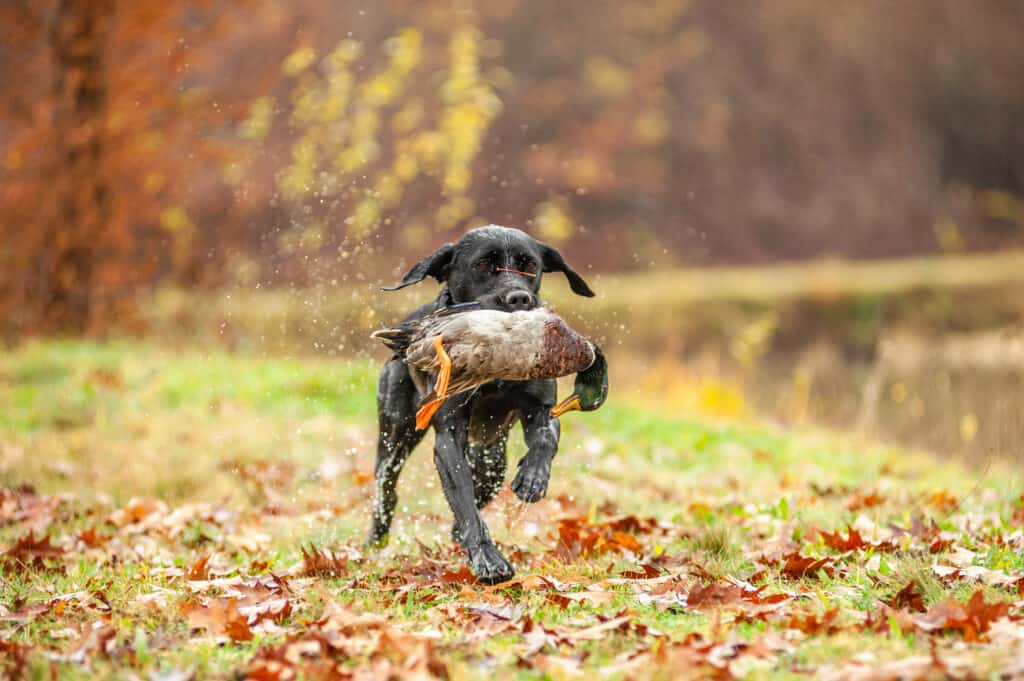
Bonding with you dog during training and them enjoying the great outdoors together and celebrating the success of a hunt are all what it’s about.
©Anna Pozzi – Zoophotos/Shutterstock.com
If you are heading out of Bozeman for an early morning hunt and you are bringing your gun dog you can see its excitement as it romps around as you load up your truck. They know what’s coming, and for dogs bred as retrievers they live to hunt. Hunting with your pup can be very rewarding. Bonding with you dog during training and them enjoying the great outdoors together and celebrating the success of a hunt are all what it’s about. Dogs that make amazing gun dogs include Labrador retrievers, golden retrievers and Chesapeake Bay retrievers.
Factors for Success
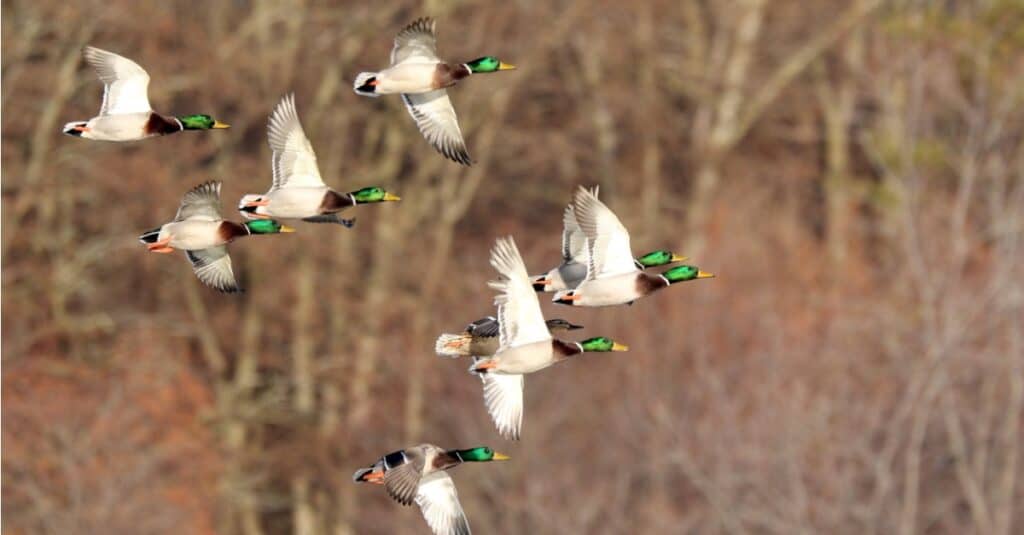
Ducks fly in a V formation to save energy.
©iStock.com/photosbyjimn
Some of the biggest factors for success are the location of your blind and the weather. You can’t predict the weather or change it for that matter, but you can be aware of the forecast a few days before your hunt. Plan ahead for cooler temps or rain and decide what you will do if you have an extra still day when ducks aren’t stirring. Cool, windy, overcast days are the recipe for success.
Choosing the location of your blind can make or break a hunt as well. Take a look at weekly harvest reports and migration patterns. Evaluate the season and wind patterns to decide if you will be in a stationary blind or if you’ll need to take a boat out. Be certain that your blind is as camouflaged as possible.
Where are the Best Places to Duck Hunt in Montana?

The large rivers like the Missouri, Yellowstone and Flathead provide surrounding wetlands and tributaries where you will find congregations of both local and migrating waterfowl.
©iStock.com/bobloblaw
The best places to duck hunt in Montana are around the Waterfowl Production Areas. There are many of them throughout the state like in the Charles M. Russell NWR. Large wetlands, smaller creeks and ponds dot the landscape in Montana and provide clse access to hunting. The large rivers like the Missouri, Yellowstone and Flathead provide surrounding wetlands and tributaries where you will find congregations of both local and migrating waterfowl. State Parks and BML land also have designated areas for duck hunting during duck season.
Meet the Species: 3 of the Most Common Ducks in Montana
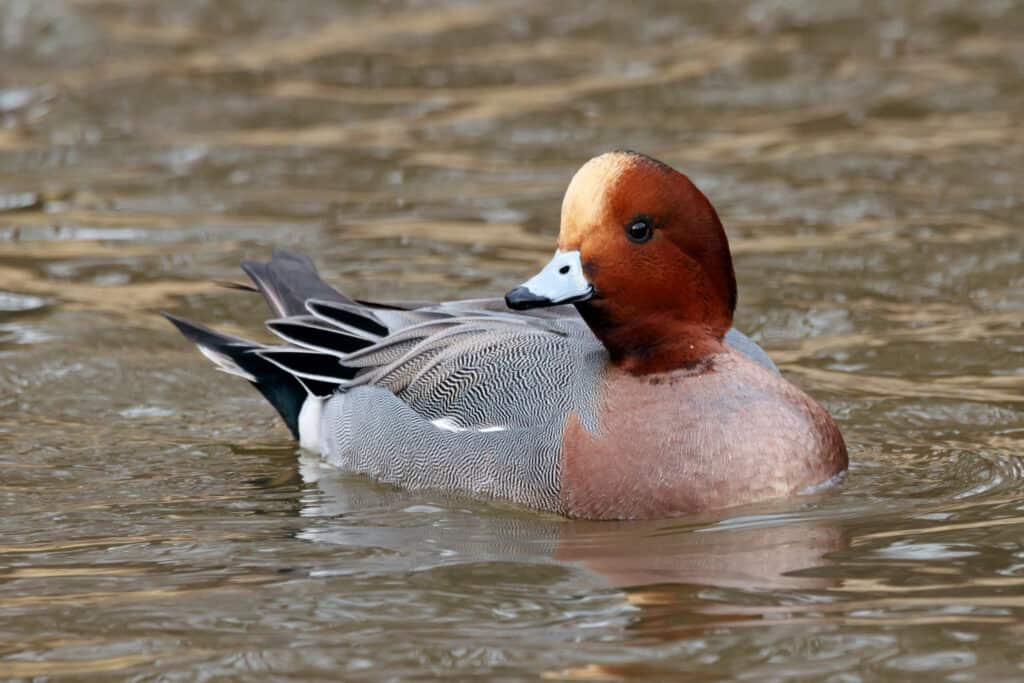
These beautiful birds have a blue-gray beak with a black tip and a green band that flows back from its eye.
©Anton MirMar/Shutterstock.com
- Mallard: Despite the variety of ducks in Montana the mallard, or commonly called greenheads by hunters, are the most harvested. These colorful ducks are what you probably think of when you think about ducks. The males have emerald green heads, bright yellow beaks, a blue patch on their wings and orange legs.
- Wigeon: The male wigeon has a green crescent shaped patch that flows back from their eyes. On their wings are two patches, a row of black and a row of white. The feathers on their bodies are a mix of brown/gray/black.
- Green-winged teal: The green-winged teal has a matching green patch on their heads and wings. The males heads are rust colored with a green patch flowing back from the eye with a black bill. Green-winged teals are the smallest of the dabbling ducks in Montana.
Up Next
- 10 Incredible Duck Facts
- The 10 Biggest Lakes in Montana
- How Deep is Flathead Lake? Discover Montana’s Deepest Lakes
The photo featured at the top of this post is © iStock.com/wayneharney
Sources
- Montana Fish, Wildlife, and Parks, Available here: https://fwp.mt.gov/hunt/regulations/migratory-bird
- 2022 Migratory Birds, Available here: https://fwp.mt.gov/binaries/content/assets/fwp/hunt/regulations/2022/2022-mig-bird--webless-final-for-web.pdf
- US Fish and Wildlife Service, Available here: https://www.fws.gov/refuge/northwest-montana-wetland-management-district
- Montana Fish, Wildlife, and Parks, Available here: https://fwp.mt.gov/hunt/access/public-lands
- Montana Field Guide, Available here: https://fieldguide.mt.gov/speciesDetail.aspx?elcode=ABNJB10010
FAQs (Frequently Asked Questions)
Can you duck hunt in Montana?
Yes, you can duck hunt in Montana. You need a Federal Migratory Bird Stamps, Montana Migratory License, Conservation License and Base Hunting License.
When does duck hunting season start in Montana?
Duck hunting season starts on Oct. 1, 2022 in both Flyways and Zones.
What are the most common ducks in Montana?
The most common ducks harvested in Montana are mallard, wigeon and green-winged teal.
What is the bag limit for Mallard ducks in Montana?
In the Pacific Flyway the limit is 7 with 2 females and in the Central Flyway the limit is 5 with 2 females.
How does Montana rank in the country for duck harvest numbers?
Montana is ranked 30th in duck harvest (based on a 10-year average).
Thank you for reading! Have some feedback for us? Contact the AZ Animals editorial team.






